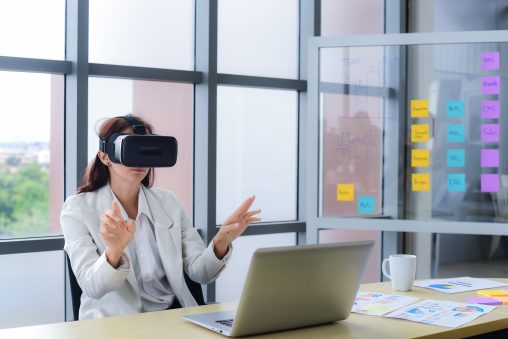The Metaverse – Echoes from the future

If it’s up to the likes of Facebook, the Internet as we’ve come to know it is on the verge of a new revolution in which it, social media and gaming are melded into one great immersive virtual world.
Just three months ago, Facebook CEO Mark Zuckerberg announced the official renaming of his company to Meta Platforms. It seemed a pretty bold move for a large corporation that pretty much dominates the social media scene and can boast over a billion users. The question arises: why did Facebook feel the need to change the name and direction of a company with $85 billion in revenue? Surely its existing business model is lucrative enough? Well, in 2019 the firm launched Facebook Horizon, a social media-based virtual reality world, and the potential it sees in the metaverse is obviously such that Zuckerberg et al believe this is the future – not just for their business, but for the entire internet
What is the Metaverse?
To come to grips with the current buzz surrounding this term one has to have a clear understanding of its meaning. The word metaverse was first used in the 1992 sci-fi novel Snow Crash, as a combination, or portmanteau, of meta and universe. In principle it is a network of virtual worlds seen and experienced in 3D, and since the 1990s has already been regarded as the natural evolution of the Internet. Something that the likes of Facebook and Microsoft clearly agree with, given the wholesale refocusing of the former’s business mission and the latter’s acquisition of AltspaceVR in 2017.

This social virtual reality (VR) platform first founded in 2013 now forms part of Microsoft’s Mixed Reality (MR) division, whose plans to develop a multidimensional, fully immersible virtual reality social media and internet experience are almost as ambitious as those of Facebook, I mean Meta. In acquiring this name, Zuckerberg has almost appropriated the concept, but this is by no means the first venture into a virtual reality world based not so much upon gaming but upon social and even economic interaction. Second Life, launched back in 2003, is generally regarded as the first iteration of the Metaverse, and as such serves as an interesting pioneering prototype.
Second Life
The creator of Linden Lab, Philip Rosedale, had been working on software that would enable people to create their own parallel life experiences in a 3D virtual world in the late 1990s, and it culminated in the launch of Second Life. Rather than a game or a dating site, Second Life provided a Sim City-like social landscape in which so-called residents could interact with one another, buy or build their own homes, cars and businesses, invent things, trade and attend cultural events, building virtual communities along the way that not only added to or replaced real-world social life, but sometimes even led to actual friendships.
The idea took off among tech-savvy people and by the end of the decade it counted a million users, with up to 50,000 or more people online at any one time. They trade in Linden dollars (L$) and can even redeem these tokens through PayPal, or among one another in real currency, and in so doing this virtual society has built up an ‘economy’ worth $500 million. Though still used by a loyal following of well over half a million, Second Life never broke through the way Facebook and others did because it is more digital-immersive and aimed at adults, who typically find it more challenging to share online experiences with strangers than youngsters do on their multiple player gaming platforms.

Other challenges had a more technical background, such as the standard of the graphics, server issues when large numbers of people were interacting, and VR headsets that remain too cumbersome to be easily portable. In fact, the very man who championed the creation of online multimedia platforms cancelled further development of Sansar in 2020, effectively abandoning what would have been the next version of Second Life. He also raises questions about the far-reaching ambitions of Microsoft, Facebook and others in relation to turning the internet into one huge connected VR world.
A new beginning?
Besides technical and practical challenges, Rosedale also fears problems on a societal level, citing the potential that metaverse could have to greatly worsen existing problems of internet addiction, social isolation, exploitation, harassment and online privacy and security. They are worries shared by many others, who fear that the metaverse, as proposed by the large tech corporations, would lead not to greater freedom and independence of content, but to enhanced centralisation of this vital resource in the hands of a few mega-multinationals with the potential to monopolise both information and its commercialisation.
Rosedale finds the use of the metaverse for advertising and personal data purposes worrying indeed, but right now such cautionary voices are being drowned out by the noises of excitement created by big tech and media alike. Just weeks ago, Disney was given permission by US federal authorities to develop its own virtual reality space and metaverse experiences at its theme parks. As an entertainment company with advanced technological capabilities, Walt Disney is well placed to take advantage of this potentially lucrative new field, but they’re not the only ones, as it seems like everyone from Facebook and Microsoft to Apple and Google wants a piece of the action.

In spite of all the hype, experts such as Philip Rosedale, creator of the first prototype metaverse, believe the technology is just not there yet to realise the visions of a multidimensional, interconnected and fully immersible internet/metaverse, and maybe that’s just as well, as it seems we may need to think hard about the technologies we want for the future before irreversibly ‘immersing’ ourselves in them.
First published in Essential Magazine










